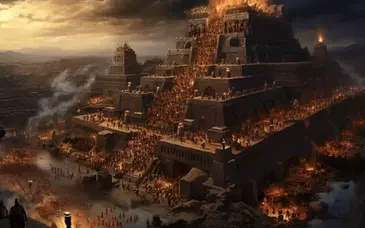The End Of The Early Civilization Period
The Rise Of Civilization In The Middle East And Africa
Date: 1992
The proliferation of spin-off civilizations brought important innovations
within the framework set by the achievements of the great progenitors in
Mesopotamia and Egypt. The simplified alphabet, the major cultural shift
described by the first great monotheistic system, and a number of quite
practical improvements - the introduction by another Mediterranean coastal
peoples, the Lydians, of coined money - considerably advanced the level of
civilization itself. The spread of civilization into Kush and into some
European portions of the Mediterranean, fed by deliberate expansion and
growing trade, also set the basis for the development of major civilization
centers beyond the original core. By 1000 B.C. the civilization zone initially
established by separate developments in Mesopotamia and Egypt had fanned out
widely, sketching the basis for later societies in the Middle East, Africa,
and parts of Europe.
No sharp line divides the long early phase of the development of
civilization in the Middle East and North Africa from the next, classical
period; there was no total overturning by invasion, as would characterize the
first civilization in India. Developments such as the spread of the Kushite
kingdom, the survival of the Egyptian kingdom, or the elaboration of the
Jewish religion continued well into the final centuries B.C. Successive
empires in the Middle East would revive or preserve many features of the
Mesopotamian pattern.
Around 1000 B.C., and for several centuries thereafter, there was a
somewhat pervasive pause in the development of civilizations in this general
region. The pause did not disrupt the Phoenician or Kushite expansion on the
fringes, nor did it shatter all civilized forms. But Mesopotamia did undergo
an unusual several-century span in which regional city-states and considerable
internal warfare brought political chaos. Egyptian politics were also
deteriorating. Early civilizations in Greece were overwhelmed (almost as
completely as their counterpart in India) by waves of invasions by
Indo-Europeans from eastern Europe. These invasions for a time reduced
politics to essentially tribal levels and virtually destroyed cultural
activities that depended on writing or elaborate workmanship.
The waves of Indo-European invasion form the clearest breaking point.
These invaders were hunters and herders initially from central Asia, who
pressed into western Asia and Europe in successive waves. The Hittites were an
Indo-European people capable of assimilating Mesopotamian values to the extent
of setting up a major empire. They also pushed back the Egyptian sphere of
influence, launching the decline of the New Kingdom and also freeing up the
southeastern Mediterranean corner for the rise of smaller states such as the
Jewish kingdom. But by 1200 B.C. the Hittites were swept away by another
invading force of Indo-Europeans (the same group that interrupted civilization
in Greece).
The Indo-Europeans, beginning with the Hittites, introduced iron use
which gave rise to more powerful weaponry and the possibility of
geographically more extensive empires based on military power. The first group
to exploit this new weaponry were the Assyrians, who began a pattern of
conquest from their base along the Tigris River. By 665 B.C. they had
conquered the whole of the civilized Middle East down to the Persian Gulf as
well as Egypt. This was a cruel people, eager to terrorize their enemies. The
Assyrians used iron, a strong and widely available metal, to arm more men more
cheaply than societies relying on bronze were able to do. Their empire was
unprecedentedly large and also unusually systematic as they collected tribute,
assimilated diverse cultural achievements, and even moved whole peoples (as
they did the Jews) in order to maintain control. The Assyrian state was not
long lived. By 612 B.C. it fell to a combination of pressures from invading
frontier tribes and internal revolt. A number of smaller successor kingdoms
followed, until another great eastern empire, the Persian, arose in 539 B.C.
The key points are these: The characteristic boundaries of the early
civilizations that had lasted so long amid a relatively slow pace of change
were beginning to yield. Invading peoples brought new ideas. The
Indo-Europeans, for example, ignored the Mesopotamian or Egyptian beliefs
about the divine attributes of kings. Rather, kings were selected by councils
formed by nobles and the army. Also, where Indo-European culture took deep
root, as in Greece, political patterns would begin to diverge from those set
in the earlier civilizations of the region. Geographical boundaries were
shifting too. Egypt faded as a major independent actor, while the Middle East
was open to new empires with greater unifying potential than ever before; and
new centers of vitality were beginning to be sketched in Africa and along the
European coast of the Mediterranean.
The stage was beginning to be shaped for the emergence of a new set of
civilizations, such as in Persia and Greece, that would build on earlier
precedents in many ways but advance new cultural and political forms. Based on
the new military technology brought by iron and on steady improvements in
shipping, these new civilizations would reach out to wider regions than the
early civilizations had usually managed. More extensive civilization zones and
new cultural and political principles, though both prepared by developments in
the early civilization period, would define the era of classical civilizations
in the Middle East and Mediterranean that began to emerge by about 800 B.C.
with the recovery of civilization in Greece and, soon, the rise of the great
Persian empire.

